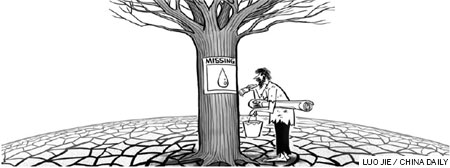How to combat water scarcity in China

Water resources management, highlighted in the No 1 central document issued in January, will in all probability be discussed at the annual sessions of the National People's Congress and the Chinese People's Political Consultative Conference.
Water resources management is very important for China because the per capita availability of water in the country is about one-third of the world average. Per capita water availability in rain-starved northern China is only one-fourth of that in the southern parts. Many rivers and lakes have dried up in the northern parts, seriously degrading the environment. Yet the north is where almost half China's population lives, and where most of its corn, wheat and vegetables are grown.
Water is even scarcer in the western parts of China, which has few water sources to meet people's demands. The economic development of the region partly depends on over-exploitation of surface and groundwater sources.
China's leadership is well aware of the deepening water crisis. It has decided to accelerate water reform and development, and proposed the most stringent measures for water resources management. These measures are aimed at limiting the total use or drawing of water, increasing water-use efficiency, and reducing the amount of pollution loads. Enforcing these measures is very challenging and the government's statement that leaders at various levels will be held accountable makes it even more so.
Follow-up work needs to be carried out to make the proposed measures more effective. Experiences and lessons from China and other countries suggest that limiting the use or drawing of water, or increasing water-use efficiency may increase rather than reduce the consumptive use of water, particularly in water-scarce areas.
Over the past two decades, China has spent huge funds in rural areas to introduce irrigation water savings programs. The programs focus on reinstating irrigation and drainage systems and promoting various water-saving technologies to increase effective irrigated areas by raising the level of water-use efficiency.
But statistics show that over the past 30 years the effective irrigated area has increased by about 8 million hectares, while the total use or drawing of water has remained much the same and the annual over-exploitation of groundwater has reached up to 22 billion cubic meters. As a result, the eco-system in these areas has degraded further.
Saving water under the traditional concept is to reduce supply and application losses, for example by lining canals, using pipes and installing sprinkler or drip irrigation. This reduces water that is "lost" when measured at point of diversion to point of delivery and field "losses", which many water officials consider water available for expanding irrigated areas or transferring to domestic or industrial uses.
But this water is not totally lost nor are the savings "real"; most of the water that "escapes" returns to the water system through run-off or percolation and can be reused again. But this "lost water" has a cost when measured and paid for as well when energy is used to divert, deliver and apply it.
 0
0 






